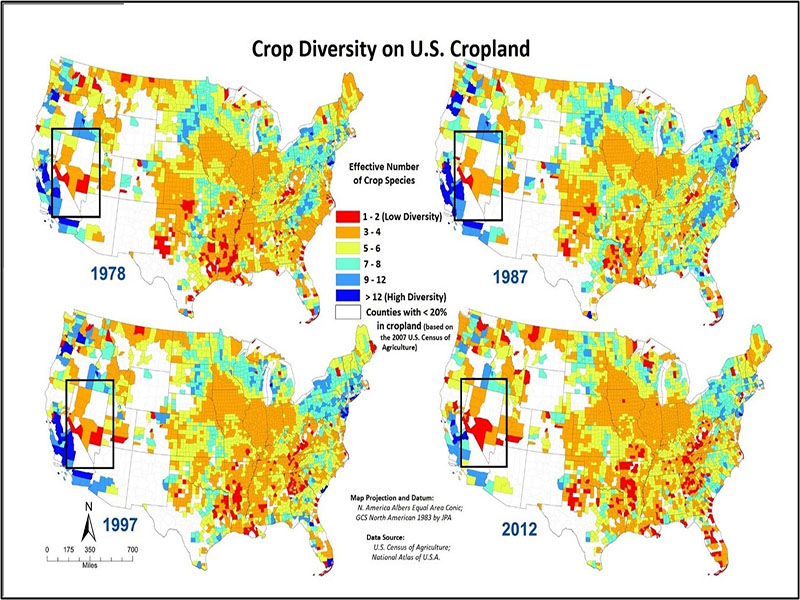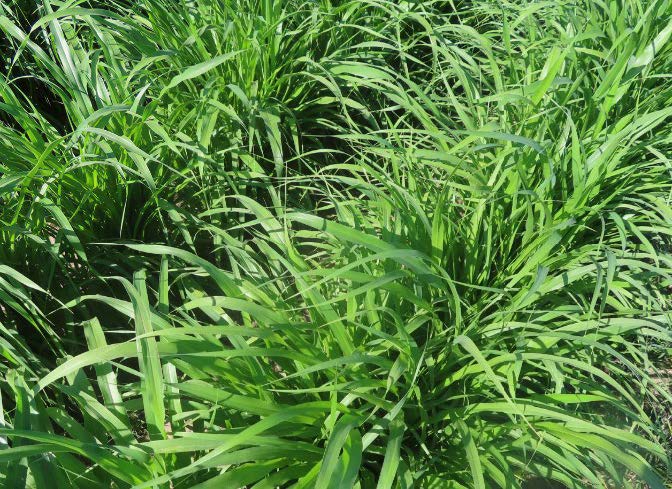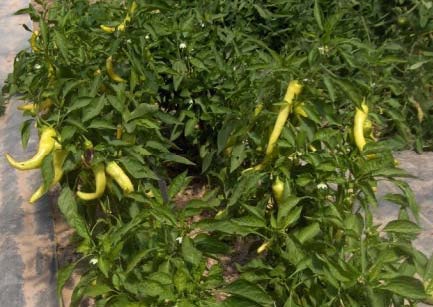Diversifying the cropping system is already being practiced by agricultural producers to overcome crop production challenges, such as high land values, increased input costs, varying weather factors, increased demands for new products, etc. These challenges are already posing obstacles to generate more revenue per acre from traditional crops such as alfalfa (Northern Nevada Business Weekly Report, 2008). Thus, sustainability concerns have raised interest in crop diversification among agricultural producers, especially throughout the world.
Crop diversification means growing more than one crop in an area. Diversification can be accomplished by adding a new crop species or different variety, or by changing the cropping system currently in use. Commonly it can mean adding more crops into an existing rotation. Diversification can also be implemented to replace low-value commodities with high-value commodities, such as vegetables and fruits. It can also include an integration of crops and livestock, defined as mixed farming. Crop diversity encompasses several aspects, such as crop species diversity, varietal diversity within crop species, and genetic diversity within crop species. It is recognized as one of the most feasible, cost-effective, and rational ways of developing a resilient agricultural cropping system.
Benefits of crop diversification
Through crop diversification, farming households can spread production and economic risk over a broader range of crops, thus reducing financial risks associated with unfavorable weather or market shocks. Growing diverse produce may also help financially by expanding the market potential. The inclusion of a variety of crops, in some areas, can lead to the development of new agriculturally based industries, improving the economic potential of a rural community. Additionally, diverse cropping systems generally provide more varied and healthier food for humans and livestock.
Production of diverse crops on the same land can produce many agronomic benefits in pest management by breaking insect and disease cycles, reducing weeds and soil erosion, and conserving soil moisture. The more diverse a farming system is with plants, animals and soil-borne organisms, the more varied the population of beneficial pest-fighting microbes in the soil. This approach may improve the economic picture of the farm by reducing production costs and increasing gross income. For example, the inclusion of legumes into rotation reduces spending on nitrogen fertilizer or adding crops (two or more) into the rotation, resulting in fewer pest problems, reducing expenditures on pesticides.
Below is a list of some potential benefits of increasing crop diversity on the farm:
- Increases income on small farm holdings.
- Helps withstand fluctuation incommodity prices.
- Provides resilience to highly variable weather conditions resulting from climate change.
- Increases profits by reducing the cost of production.
- Provides more varied and healthful Food, both for humans and livestock.
- Decreases pest pressure, including diseases, insects and weeds.
- Enhances beneficial pollinator populations.
- Improves soil quality.
- Increases employment opportunities.
- Diverse rotations may increase crop yields and produce quality.
Some potential challenges to increased adoption of crop diversification on the farm are:
- Market demand may be limited by a range of factors, such as government policies, subsidies, etc.
- Lack of infrastructure for storage and transportation.
- Absence of suitable equipment.
- Price and supply of inputs.
- Lack of technical knowledge and references regarding their production practices.
- Lack of crop varieties adapted to the specific region.
- Fear of increased complexity.
- Public regulations.

Figure 1: Crop species diversity as effective number of species in 1978, 1987, 1997 and 2012 on a county level basis for the contiguous U.S. (Adapted from Agullar et al., 2015). Black outlined areas focus on Nevada.
Although agriculture has been hugely successful at meeting the needs of an expanding world population, in terms of food, feed and fiber, agricultural intensification may have reduced crop biodiversity (Agullar et al., 2015). Figure 1 illustrates changes in crop diversity, over a multiple-year period, in the United States as a whole. However, in the Basin and Range areas comprising most of Nevada and parts of other western states, researchers found that there has been no significant change in crop diversity over multiple years. Within Nevada, 90% of cropland is in the production of alfalfa or grass hay, and not much crop diversity is found. The area outlined in black demonstrates changes in the species grown in Nevada over more than three decades. In three counties (Humboldt, Nye and Lincoln) out of a total of 17 Nevada counties, little change has been noticed over the years, as shown in Figure 1.
In Humboldt County, there is a decrease in the number of species grown from five to six species to three to four species for the 20-year period from 1978 to1997. Similarly, a reduction in crop species from three to four to one to two was observed in Nye County in the 10-year period from 1987 to1997. In contrast, an increase in the number of crops planted from one to two species to three to four species was found in Lincoln County over the 15-year period from 1997 to 2012. Not many changes were observed in crop diversity until 2012 in Nevada, as illustrated in Figure 1. Similar to the trend observed in Lincoln County, increased interest in alternative crops or adding variety to their already existing crops has been found in nearly every recent agricultural-related need assessment conducted by University of Nevada, Reno Extension faculty in various counties. This increased interest might be related to the rise in the number of challenges the crop producers face to raise profitable crops in Nevada, such as water rights, droughts, soil erosion, degraded soil quality, persistent pest problems, etc.
Choosing diverse crops
Always look for opportunities to diversify your farm and markets. When selecting new crops, consider which crops are a good fit for your soils, climate, available equipment, irrigation and closeness to buyers. To increase the chances of success, a producer should always complete a thorough investigation of potential crops and markets before planting any new crop species.
The best source for determining if a new crop species has previously been grown in the area is to search online resources of the University of Nevada, Reno Extension or consult with local Extension personnel. Table 1 and Figures 2 and 3 show selected crops grown in Nevada over the last few years. It is always best to find other producers with experience growing crops you are considering. The producer is also advised to start on a small acreage with any new crop species before any large-scale production is planned. Producers must develop skills related to their production practices, management, pest control, harvesting and marketing of the new product.
Table 1: Selected crops tested and grown in Nevada.
| Group |
Crops |
| Vegetables |
Lettuce, onion, potato, mint, garlic, summer and winter squash, melon, tomato, amaranth, pepper, eggplant, radish, broccoli, peas, turnip, carrot, beet |
| Forage |
Great Basin or Basin wild rye, barley, teff, corn, pearl millet, triticale, timothy, wheat |
| Grains/Seed |
Barley, teff, amaranth, corn, soybean, dry bean, sorghum, chickpeas, spring, and winter canola |
| Fruits |
Grape, prickly pear, Seaberry |
 Figure 2: Pearl millet grown in Churchill County. (Adapted from University of Nevada, Reno Extension Fact Sheet 19-11).
Figure 2: Pearl millet grown in Churchill County. (Adapted from University of Nevada, Reno Extension Fact Sheet 19-11).

Figure 3: Sweet banana peppers grown in Lincoln County. (Adapted from University of Nevada, Reno Extension Special Publication 12-07).
Conclusions
Diverse cropping systems tend to decrease the probability of widespread crop failures and pest pressure, and improve soil quality and crop yields. To support healthy, sustainable and profitable crop production in Nevada, producers should start looking for opportunities to add new crop species into their existing rotation. This addition will assist them in overcoming challenges presented by climate change, especially droughts and issues of water usage in Nevada as the demand for water increases. Additionally, changes in the policies that encourage crop diversity may be needed to support efforts to ensure community food security.
Acknowledgment
Funding for this publication was provided by the Agriculture and Food Research Initiative Competitive Grant award number 2017-70006-27198 from the USDA National Institute of Food and Agriculture (NIFA).
References
- Aguilar, J., Gramig, G.G., Hendrickson, J.R., Archer, D.W., Forcella, F., and Liebig, M.A. 2015. Crop Species Diversity Changes in the United States: 1978–2012. PLoS ONE 10(8): e0136580.
- Bishop, C., Curtis, K., and Emm, S. 2010. Evaluating alternative low-water-use-crops for the Great Basin. University of Nevada, Reno Extension Curriculum Materials-10-03.
- Curtis, K.R., Emm, S., and Enstsminger, J.S. 2008. Landowner Willingness to Adopt Alternative Cropping and Irrigation Strategies in the Walker River Basin. University of Nevada, Reno Extension Fact Sheet-08-19.
- Davison, J. 2002. Evaluating the potential of an alternative crop. University of Nevada, Reno Extension Fact Sheet-02-54.
- Feliciano, D. 2018. A review on the contribution of crop diversification to sustainable development goal 1 “No poverty” in different world regions. Sustainable Development 27:795-808.
- Gatzke, H. 2012. Hoop house production in the desert: Solanaceae and Cucurbitaceae crops. University of Nevada, Reno Extension Special Publication-12-07.
- Mango, N., Makate, C., Mapemba, L. et al. 2018.The role of crop diversification in improving household food security in central Malawi. Agriculture & Food Security 7, 7.
- Morel, K., Revoyron, E., Cristobal, M.S., and Baret, P.V. 2020. Innovating within or outside dominant food systems? Different challenges for contrasting crop diversification strategies in Europe. PLoS ONE 15(3): e0229910. https://doi.org/10.1371/journal.pone.0229910.
- Northern Nevada Business Weekly. 2008. Crop-diversification campaign launches seminar series. Northern Nevada Business Weekly. Retrieved from https://www.nnbw.com/news/crop-diversification-campaign-launches-seminar-series/.
- Walia, M.K. 2019. Benefits of cover crops. University of Nevada, Reno Extension Fact Sheet-19-11.
Walia, M
2020,
Crop Diversification,
Extension | University of Nevada, Reno, FS-20-28


